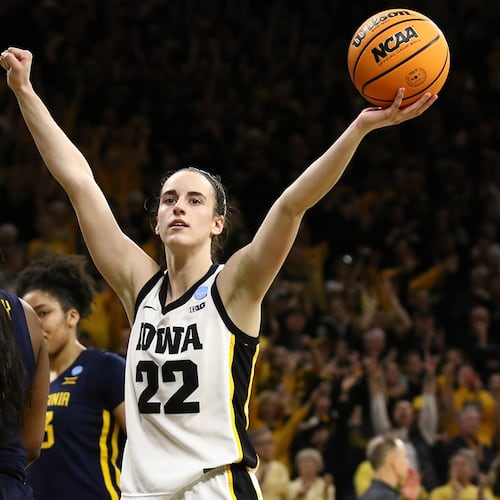The Braves awoke Friday ranked 26th among MLB’s 30 clubs in starters’ ERA. That’s after being 12th last season, when they won 97 games and a division title, and fourth in 2018, when they won 90 and likewise finished first in the National League East. There are mitigating circumstances for this falloff, but starters’ ERA is among the most important numbers in the sport. For a team that rebuilt around pitching, being 26th is shocking and scary.
Shocking in that the 2020 Braves figured they had enough arms to stock more than one rotation. Then Felix Hernandez opted out and Cole Hamels stayed hurt and Mike Foltynewicz fizzled (again) and Mike Soroka tore his Achilles tendon and Sean Newcomb fizzled (again), and now the rotation is down to Max Fried and … um, Max Fried.
Scary in the sense that nobody ever won anything of consequence with one reliable starting pitcher. Steve Carlton won 27 games with a 1.97 ERA for the 1972 Phillies. (Going by Baseball-Reference WAR, it’s the second-greatest pitching season of the past 106 years.) The ’72 Phillies won 32 other games and finished last in a six-team division.
Scary also, seeing that this is the second consecutive year in which Foltynewicz and Newcomb have been shipped to the minors – or the taxi squad, in this minors-less season. Last week we reviewed the arms accumulated under John Coppolella, the conclusion being the Braves’ pitching yield from that manic period was (apologies for quoting myself) “pretty darn good.” But it’s PDG only if you believe Foltynewicz and Newcomb remain capable of holding spots in a big-league rotation, a premise rendered iffier by Newcomb’s banishment after yielding eight runs while managing four outs Monday.
Once upon a time, Foltynewicz and Newcomb held rotational spots. From June 2016 through June 2019, the former started 86 times; from June 2017 through April 2019, the latter started 52 games. Foltynewicz was an All-Star in 2018, finishing eighth in Cy Young voting. Newcomb came within one strike of a no-hitter against the Dodgers on July 29, 2018. These were former Round 1 picks – neither was drafted by the Braves – with big-time arms. And yet …
Both were demoted in 2019. Both were demoted in 2020. (Indeed, Foltynewicz was designated for assignment. Had any other team claimed him off waivers, he’d be gone. As is, he’s not on the 40-man roster.)
As best we can ascertain, neither is having arm issues. If they were, they surely would be on the disabled list. Even so, the decline in Foltynewicz’s velocity is alarming. Per Brooks Baseball, his four-seamer averaged 96.8 mph in 2018; it was down to 91.3 this year. His slider, his best pitch when he’s at his best, averaged 87.21 in 2018; it was down to 79.92 before this year’s DFA’ing. Newcomb’s fastball is almost exactly where it was in 2018, but his strikeout rate is at a career low.
When big arms that apparently aren’t sore arms go bad, the knee-jerk response is to blame the pitching coach. Foltynewicz and Newcomb had their best seasons in 2018 under Chuck Hernandez, who was fired that October. Alex Anthopoulos, then completing his first year as general manager, wasn’t a Hernandez fan, because why else change coaches after winning a division? Rick Kranitz was hired in December 2018, one month after the Phillies dismissed him.
As convenient as it might be to lay the failings of Foltynewicz and Newcomb at Kranitz’s feet, how then would we explain the breakthrough successes of Soroka and Fried? (Remember, Soroka hurt his leg, not his arm.) As an organization, the Braves like Kranitz a lot. That sentiment suggests – if consecutive seasons of demotions didn’t already – they’ve simply wearied of Foltynewicz and Newcomb underperforming.
Because the two were acquired when the Braves were loading up on young pitchers – Foltynewicz in the Evan Gattis trade of December 2014, Newcomb in the Andrelton Simmons deal of November 2019 – we tend to think of them as young pitchers. They really aren’t. Foltynewicz will turn 29 in October. Note: Julio Teheran started 239 games for the Braves; he’s 29. Newcomb is 27, older than Shane Bieber (25) and Jack Flaherty (24), not to mention Fried (26) and Soroka (23).
It’s fair to say the Braves aren’t far from the time when they must consider a future without Foltynewicz and/or Newcomb. Foltynewicz was signed for $6.425 million this season and will again be arbitration-eligible. Newcomb can file for arbitration this winter. Liberty Media just reported a 95 percent loss in Braves revenue for the year’s second quarter, over which there were no games and no fans. Soon now, this club will need to spend big to keep Freddie Freeman, whose contract lapses in 2021, and perhaps less big to retain Dansby Swanson, who can become a free agent in 2022.
The money lost because of the pandemic will never be replaced. There’s no assurance as to what next season, assuming there’s a next season, will bring. Take Foltynewicz and Newcomb off the board and the franchise dynamics change. Without either/both of those as contributing starters in the years ahead, the burden falls on Kyle Wright (6.75 ERA), Touki Toussaint (7.27), Bryse Wilson (10.80) or Huascar Ynoa (8.10). Hope remains for Ian Anderson, the No. 3 pick in the 2016 draft, but he’s 22 days older than Ynoa and he’s not here yet. That’s an indication of … something.
A rotation including Soroka, Fried, Foltynewicz and Newcomb at full health and in peak form would be formidable. Soroka figures to be back next year – again, it’s his leg – and Fried is fifth among big-league pitchers in WAR. As for the other two, nobody knows. Beyond those two, it gets dicey.
About the Author
The Latest
Featured


